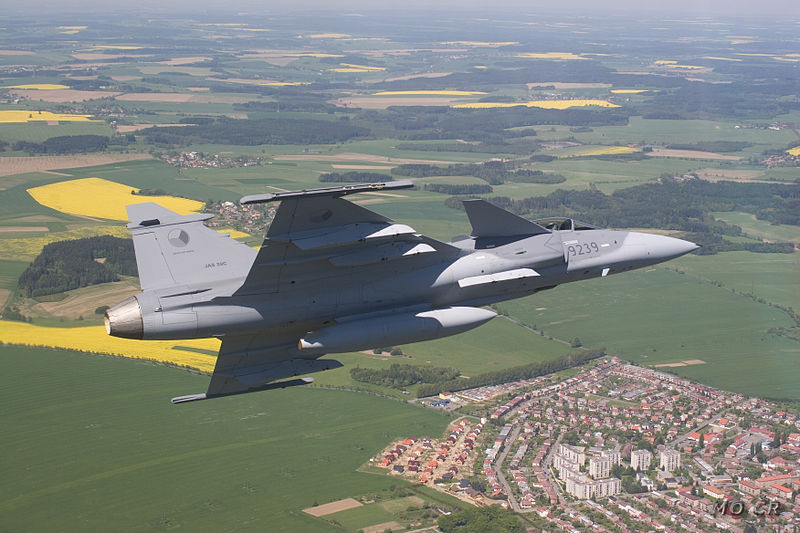http://robotpig.net/aerospace-news/saab-new-stealth-fighter-program-_1827
SAAB is investigating the design of the next generation fighter that will someday eventually replace the Gripen. The photo above is from a small research program that SAAB is conduction with the University of Linköping. The program entitled Generic Future Fighter Aircraft aims to develop a cost-effective and quick way to design and manufacture a demonstrator concept and also to evaluate the usage of this scaled demonstrator as a development and evaluation tool.---
The prototype is a 13% scale radio controlled model that uses a small 160N jet engine. It weighs 15kg and it has 2,4m length and 1,5m wingspan. It looks similar to the Gripen and the main difference is the V-tail instead of the conventional vertical stabilizer. This small prototype isn't representative of a future fighter, however the arrangement of its control surfaces is similar to other drawings that SAAB has released in the past:
These images are from an official SAAB presentation for a next generation fighter. It is bigger than the very compact Gripen and has two engines. It has a faceted fuselage with small internal weapon bays for air-to-air missiles. Bigger payload will be carried externally and there will be provision for tight integration with UCAVs. The general arrangement apart from the engines and stealth surfacing is similar to the flying scale demonstrator and this is a strong indication that this general design is highly considered. A V-tail has a lot of advantages for a stealth aircraft. It replaces four (twin engine fighter jets usually have two vertical stabilizers) surfaces with two and avoids the vertically intersecting planes. It also reduces drag and if combined with vector nozzles can be also very compact.
SAAB is also researching other stealth elements like air inlets that shield the compressor from the radar radiation. In the image above the sketch on the left is from a SAAB patent regarding a stealth airplane and is similar to the DSI (divertless supersonic intake) that was tested in a F-16 prototype in order to evaluate the concept for X-35/F-35. This design uses a bump to deflect the shockwave when the aircraft approaches the speed of sound and its form blocks the direct view to the compressor thus rendering a radar blocker unnecessary.
Video and details on the Linköping University project: http://www.iei.liu.se/flumes/aero/gff
(Images from SAAB / Linköping University , F-16/X-35 images from LM)
SAAB is investigating the design of the next generation fighter that will someday eventually replace the Gripen. The photo above is from a small research program that SAAB is conduction with the University of Linköping. The program entitled Generic Future Fighter Aircraft aims to develop a cost-effective and quick way to design and manufacture a demonstrator concept and also to evaluate the usage of this scaled demonstrator as a development and evaluation tool.---
The prototype is a 13% scale radio controlled model that uses a small 160N jet engine. It weighs 15kg and it has 2,4m length and 1,5m wingspan. It looks similar to the Gripen and the main difference is the V-tail instead of the conventional vertical stabilizer. This small prototype isn't representative of a future fighter, however the arrangement of its control surfaces is similar to other drawings that SAAB has released in the past:
These images are from an official SAAB presentation for a next generation fighter. It is bigger than the very compact Gripen and has two engines. It has a faceted fuselage with small internal weapon bays for air-to-air missiles. Bigger payload will be carried externally and there will be provision for tight integration with UCAVs. The general arrangement apart from the engines and stealth surfacing is similar to the flying scale demonstrator and this is a strong indication that this general design is highly considered. A V-tail has a lot of advantages for a stealth aircraft. It replaces four (twin engine fighter jets usually have two vertical stabilizers) surfaces with two and avoids the vertically intersecting planes. It also reduces drag and if combined with vector nozzles can be also very compact.
SAAB is also researching other stealth elements like air inlets that shield the compressor from the radar radiation. In the image above the sketch on the left is from a SAAB patent regarding a stealth airplane and is similar to the DSI (divertless supersonic intake) that was tested in a F-16 prototype in order to evaluate the concept for X-35/F-35. This design uses a bump to deflect the shockwave when the aircraft approaches the speed of sound and its form blocks the direct view to the compressor thus rendering a radar blocker unnecessary.
Video and details on the Linköping University project: http://www.iei.liu.se/flumes/aero/gff
(Images from SAAB / Linköping University , F-16/X-35 images from LM)


